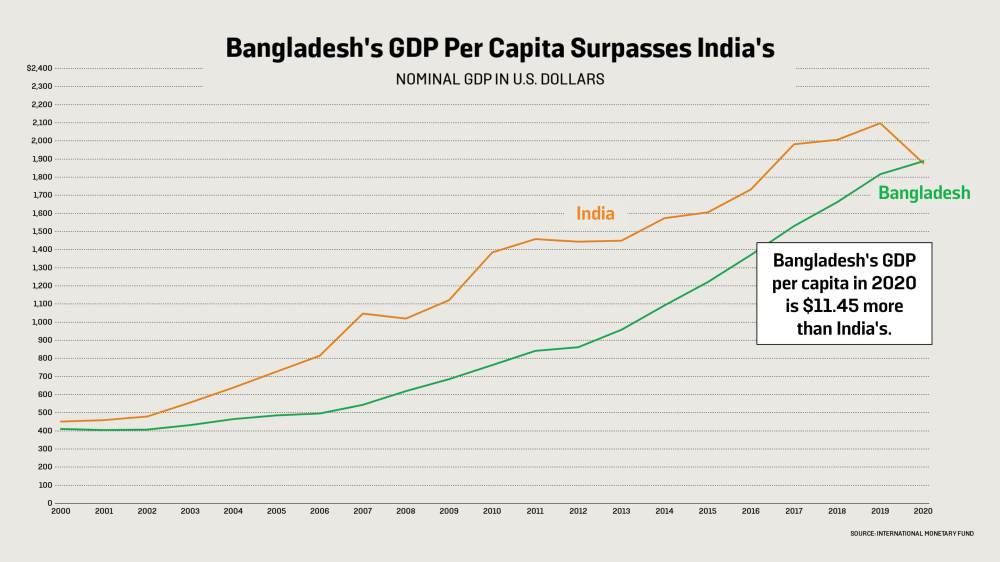Bangladesh, once far behind, just surpassed India in GDP per capita. All the more reason for Modi to focus on the right reforms.

foreignpolicy.com
Angst and Denial in India as It’s Now Officially Poorer Than Bangladesh
Once dirt-poor Bangladesh just surpassed India in GDP per capita. All the more reason for Modi to focus on the right reforms.
BY
SALVATORE BABONES | OCTOBER 20, 2020, 5:33 PM
Indian Prime Minister Narendra Modi participates in a committee meeting at the Parliament House in New Delhi on March 3, 2020. PRAKASH SINGH/AFP VIA GETTY IMAGES
Mirror, mirror on the wall, who’s the poorest of them all? When Bangladesh emerged as an independent country in 1971, it was arguably the poorest country in the world—or close to it. Today, the country is still poor but growing rapidly. Real economic growth exceeded 8 percent in 2019, and although the coronavirus crisis has slowed the pace, growth is expected to continue at a more modest pace of
around 4 percent in both 2020 and 2021. Bangladesh’s estimated 2020 GDP per capita of $1,888 now places the country far above many of the desperately poor countries of tropical Africa with which it used to be compared. And it puts Bangladesh exactly one spot above neighboring India in the latest economic
league tables from the International Monetary Fund (IMF).
When the news broke, the Indian press went wild in a paroxysm of
angst,
finger-pointing, and
denial. In Bangladesh, the response was more
measured. In China, unsurprisingly, the state-run media
blamed India’s fall from grace on “the Indian government’s refusal to rectify relations with its neighbors” and its recent ban of Chinese social media apps. The international press hardly noticed at all, although Bloomberg’s Andy Mukherjee did
chide India for not promoting low-wage manufacturing exports as Bangladesh has, citing a
paper from the economists Shoumitro Chatterjee and Arvind Subramanian. But even if India stole all of Bangladesh’s low-wage exports, it would create barely a blip in India’s GDP figures. India doesn’t need more low-wage jobs. It needs higher incomes for ordinary workers, both in rural areas and in urban slums, and these can only come from economic reforms that benefit the millions, not the millionaires.
That said, the GDP figures that shocked India are less shocking than they appear. The IMF projects that Bangladesh will produce exactly $11.45 more per person than India in 2020, when their economies are compared in U.S. dollar terms, using average exchange rates as a guide, and assuming that population estimates for both countries are accurate. However, international estimates of Bangladesh’s population differ by several million and of India’s by more than 50 million. And unlike the Indian rupee, the Bangladeshi taka does not trade freely and is
widely believed to be overvalued. The IMF itself does not primarily make international comparisons based on exchange rates (often called “nominal” comparisons), preferring instead to use purchasing power parities (PPPs), which adjust for the cost of living in a country. Evaluated on a PPP basis, India’s GDP per capita of $6,284 is still well above Bangladesh’s $5,139. And even in nominal terms, Bangladesh didn’t actually overtake India; India dipped below Bangladesh due to the economic impact of the coronavirus.
That’s a lot of ifs, ands, and buts. Bangladesh’s accomplishments shouldn’t be minimized, and despite the many
controversies surrounding its garment industry, clothing exports have been the backbone of Bangladesh’s export economy. Still, despite Bangladesh’s export boom and its status as a textbook case for both the successes and the failures of export-led industrialization, exports
account for only 15 percent of GDP, compared with 19 percent for India. Export statistics are highly variable, but India’s export levels began to exceed Bangladesh’s in the wake of the 1997 Asian financial crisis and have remained higher ever since. That is all the more remarkable since larger countries usually trade less (as a proportion of GDP) because they have larger home markets. India’s exports as a proportion of GDP are now on a par with China’s, which is certainly no mean feat.
Those who
call for India to follow Bangladesh (and looking further back, China) in the development of a low-skill, low-wage manufacturing export sector also neglect the realities of India’s economic geography. The two poorest states in India are also the two largest: Uttar Pradesh (with a
population of around 238 million) and Bihar (around 125 million). Together they account for more than a quarter of India’s population, and in economic terms they are on a par with some of the poorest countries in the world. They are probably the only states in India where the development of export-oriented, low-wage manufacturing industries would represent a step up on the value chain. But they lack the necessary port access to support the emergence of such industries, especially given the poor state of India’s infrastructure and logistics capacity. The razor-thin margins on the manufacturing of shoes, apparel, toys, accessories, and other light goods mean that transportation costs matter much more than in other sectors. Uttar Pradesh and Bihar are just too far inland to compete.
The truly pressing need in these two states—and in the North Eastern Region, India’s second poorest—is for higher
farm incomes. India is still a country of farmers, with
40 percent of the population employed in agriculture (down from 60 percent at the turn of the millennium). Uttar Pradesh, Bihar, and the North Eastern Region all tend to have a multiplicity of
small farms that support a large part of the population at poverty-level incomes. Historically, Indian governments have squeezed farmers to ensure an affordable supply of food for urban consumers. In the latest example of this, in September the government of Narendra Modi’s Bharatiya Janata Party (BJP) banned the
export of onions to combat rising prices that might have benefited farmers, once again forcing them to subsidize much richer city dwellers. A few days later, the BJP performed a spectacular somersault, pushing major
agricultural reform legislation through the upper house of India’s parliament on a
controversial voice vote. The 2020 Farm Acts will allow farmers to circumvent purchasing cooperatives to sell their produce to the highest bidder. The new law will also allow farmers to sell their crops upfront, before planting. Minimum price supports will remain in place, but farmers will now be able to seek higher prices—and earn higher incomes.
The key to growth is income, not jobs. Too often, development economists look for a single, visible source of employment to soak up excess farm labor and inevitably hit on large-scale, low-wage manufacturing. But when farmers have money, they spend it in all sorts of low-visibility niches. Whether they buy fertilizer or flip-flops, the important thing is that they’re spending, and by spending they create jobs for others. Rising mass incomes generate mass employment, and as the German economist Hartmut Elsenhans
argues, they do so while preserving the political conditions for future growth. By relying on wage suppression to fuel export growth, Bangladesh has entered a self-limiting blind alley from which it will be difficult to emerge. India’s more open, more flexible economy stands a better chance of success, not least because the farm reforms will make it politically difficult for any future government to restrict agricultural prices, as the BJP itself did just last month.
The first practical test of the popularity of Modi’s farm reforms will come over the next few weeks as Bihar goes to the polls in multistage legislative assembly elections. Of course, agriculture is hardly the only issue in the news, with the coronavirus, corruption, colorful personalities, and the
police cover-up of a horrific gang rape in neighboring Uttar Pradesh also grabbing voters’ attention. But in the long run, the staying power of the BJP’s reform agenda may be the most important issue for the future development of India. It was India’s last BJP prime minister, Atal Bihari Vajpayee, who pushed through the privatization of state-owned firms that led to India’s first export boom 20 years ago. Those reforms were controversial at the time, but they stuck, and they changed India’s economy forever. Having previously broken up many of the most moribund monopolies at the top of India’s industrial hierarchy, the BJP is now promising to undermine the petty powers of the local agricultural monopolies at the bottom. If they succeed, the results could be transformative for poor farmers. But if the government can’t help crying over the price of onions, it might as well throw in the towel and give someone else a shot at reform.

When the Arabs dared to raise their hands on us, we threw them off their own villas.












